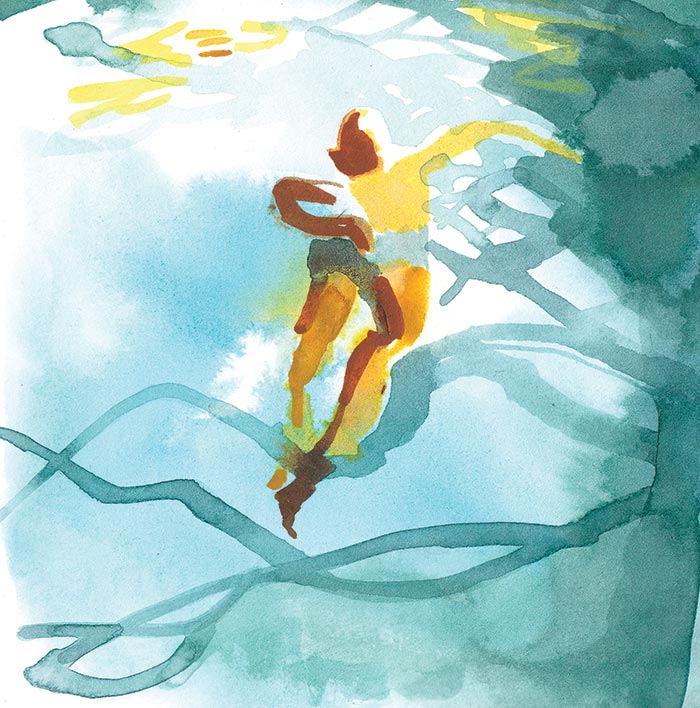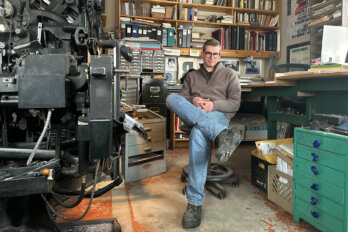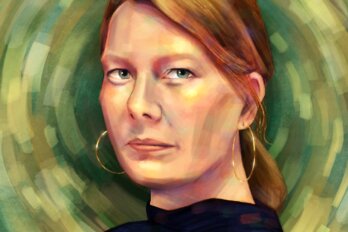
It was fifty years ago today, or near enough. Sgt. Pepper has not yet taught the band to play; instead, from the top of the charts, smoke gets in your eyes. Frank Sinatra has high hopes, but Miles Davis is kind of blue. Roman chariots crash on the big screen, American stagecoaches on TV. Buddy Holly falls from the sky. Canada opens a seaway while Vietnam opens a trail. Khrushchev and Nixon debate communism versus capitalism in Moscow; a 36”-18”-33” woman named Barbie spreads her plastic legs in New York and settles the argument. In July, a nuclear reactor north of Malibu overheats, releasing radiation into the warm California air.
All that summer of 1959, a novel sits atop the Canadian bestseller lists that knows none of this but is about all of it. Published in February, Hugh MacLennan’s The Watch That Ends the Night rises to number one on the Quill & Quire list in June and stays on top until September. (Below, a barely legal Lolita tussles with the newly legal Lady Chatterley’s Lover.) In New York, Scribner’s bookshop on Fifth Avenue gives the Canadian novel its window, stacks of copies among blow-ups of reviews from the Times and the Herald-Tribune and photos of its exotic settings—Montreal, Ottawa, a generic lumber camp. Hollywood knocks. The movie will never be made, but with $70,000 in film rights plus pocket change from book sales, the man from Cape Breton finally doesn’t have to care.
John Hugh MacLennan was born a century ago in the coal mining town of Glace Bay. His mother was a Glace Bay girl, Highland Scot, the kind who writes poems in her spare time. His father was a doctor, Highland Scot, the kind who studies the classics in his spare time and enforces the Sabbath and drives his daughter to a breakdown and his son to a Rhodes Scholarship—and when the telegram arrives tells the boy the walk needs shovelling.
MacLennan spent the 1930s quarrelling with his father’s Calvinist God. (Freud helped.) He studied classics at Oxford, struggling for Scottish pride to keep up with his British betters while dreaming of being Keats 2.0 and proving the first of his substitute gods right by sublimating rebellion and sex into tennis, rugger, cycling, and running—running every afternoon around Christ Church Meadow, running in circles. After graduation, he ground through a Princeton Ph.D., flirted with Marx, and wrote pastiches of Hemingway, Joyce, and Lawrence to which twenty-eight publishers mercifully said no thanks, been there, done that. Running in circles.
Plop went the sound of Hugh landing back in Canada, teaching at a Montreal boys’ school (Lower Canada College) instead of a university because it was still the Depression, and because his Oxford tie and Princeton pin notwithstanding, he was still a Canadian. He married a year later, Dorothy Duncan, a Chicago woman with a B.Sc. in botany and a ticking bomb in her chest, a heart damaged in childhood. Dorothy had her own authorial ambitions, publishing the lifestyle book You Can Live in an Apartment the year Hitler invaded Poland. Of more lasting importance, she persuaded her husband to set his third attempt at a novel at home, in Canada.
Barometer Rising, Hugh MacLennan’s first published novel, is the story of the Halifax explosion. This was home turf with a bang: when the Imo and the Mont-Blanc collided on the morning of December 6, 1917, killing 2,000 in the largest man-made explosion before the atomic bomb, its future author was in the bathroom of his home on South Park Street, just blocks from the harbour, washing his knees for school (it’s the era of short pants). His father tended the maimed and the blind; ten-year-old Hugh wandered the devastated streets. (MacLennan’s childhood home survived the explosion, only to be torn down in 1993 by the cbc.)
For Canada’s most nationalist novelist, nationalism was a career choice. As he wrote to a friend, MacLennan included the substantial glosses on Canadian geography and history in Barometer Rising because he had to explain Canada to his New York publisher and its American market, practically the only market for Canadian fiction up to his time. But with the novel’s success among Canadian reviewers and even some readers, MacLennan became convinced that Canadians were hungry for a spokesman. The job was far from his first choice—he wanted to be a writer for the world—but at least it was a job, and with the Depression leering its reminder in the rear-view mirror, MacLennan took it.
The nation confirmed his choice, asking and getting his opinion on all things Canadian for newspapers, magazines, radio, and later TV and the universities. Two Solitudes, his second novel, won the first of his five Governor General’s Awards and bought him and his wife a summer cottage in the Eastern Townships. Emboldened, he ventured a more “universal” (read “American”) story in his next, The Precipice, but after Canadian reviews accused him of selling out he ran home for the most Oedipal novel of this always Oedipal author, the father-slaying tragedy of a Cape Breton colliery doctor called Each Man’s Son.
Two Solitudes is MacLennan’s best-known novel, one of those rare books whose title alone shaped how this country speaks and thinks. The Watch That Ends the Night is his best novel. It’s told by cbc reporter and McGill professor George Stewart, based on MacLennan himself. The novel opens in early 1951 with George taking a phone call from a dead man: Jerome Martell, George’s wife Catherine’s first husband, reportedly killed twelve years earlier by the Nazis in France. Once the best surgeon in Montreal, Jerome left Catherine to volunteer in a surgical unit in the Spanish Civil War and has spent the years since in France, Poland, Russia, and China fighting fascism by whatever name. From here, the novel flashes back in George’s memory to the start of this love triangle amid the Depression.
The Watch That Ends the Night is an elegy. First, it’s an elegy for Dorothy, dying, like Catherine, of a rheumatic heart, dying through most of the eight years it took to write the book. Dorothy finally passed the day after Easter 1957. Eight months later, MacLennan finished the novel and dedicated it to his wife: “To you, wherever and whatever you may be, my thanks and this book.” Publicly, he made the usual novelist noises about Catherine being a fictional character, but when his publisher and close friend John Gray read the manuscript, he told MacLennan he could not see it as fiction, could not edit the lives of his friends.
Mostly, though, The Watch is an elegy for Canada, for the Canada that might have been. Through his memories, George takes his readers back to the 1930s, back to a generation searching for something, anything, to replace the shattered faiths of their fathers. Marxism. Communism. Socialism. Fascism. Social Credit. The ccf, the lsr, the cpc, dreams mouldering under forgotten acronyms. “Was there ever a time,” asks George, “when so many people tried, so pathetically, to feel responsible for all mankind? Was there ever a generation which yearned to belong, so unsuccessfully, to something larger than themselves? ”
Jerome is the novel’s big, bold hero of the hungry 1930s: the man of ideals and action, as good with a bayonet as with his surgeon’s scalpel. With his shirt off, he looks like a boxer. George is its hero of the 1950s: a nice little man in a meaningless job who dreams of a warm apartment after a cold walk, a drink before dinner, a good night’s sleep. He doesn’t take his shirt off, but if he did he’d look like a professor. Let’s finish the allegory: Catherine is the Canada they both love, her damaged heart a metaphor for a generation that never felt safe, a generation that came of age in the Depression, remembers two World Wars, and lives under the Bomb.
The plot and the times side with George. George gets all he wants and more, Catherine and the daughter Jerome left behind. Jerome gets his surgeon’s hands smashed by the Nazis. By the 1950s, the ideals of the ’30s were just a memory, broken in war and forgotten in Canada’s postwar affluence. MacLennan lost what faith he had in communism after a disillusioning trip to Russia in 1937, a trip George makes for the cbc the same summer and with the same result: “See Russia,” he hears a fellow traveller say while in Leningrad, “and let your theories die.”
Hugh MacLennan was a very earnest writer, very cbc. And like the cbc, he was best at documentary. Better than any book I know, The Watch That Ends the Night captures its generation’s loss of faith in both religion and politics, and the resulting quandary of having to find meaning in units no larger than the family. “Prosperous under the bomb,” says George, “we all seemed to have become atomized. Wherever I looked I saw people trying to live private lives for themselves and their families… The gods, false or true, had vanished. The bell which only a few years ago had tolled for all, now tolled for each family in its prosperous solitude.” That, not the youth or corrupt politicians, is the source of voter apathy in Canada: the generation of Canadians who gave up on citizenship, who abandoned the polis for the oikos and its summer cottage.
The Watch is the fictional counterpart to economist John Kenneth Galbraith’s The Affluent Society, a bestseller the same year; both depict a society that has lived through the Depression and the Second World War and come out materially comfortable and politically secure, but existentially bankrupt, with nothing bigger to believe in than the shiny new cars in the driveways of its shiny new homes. MacLennan saw all that Galbraith saw, understood it—and ran straight into the arms of God. Atheist or agnostic for most of their adult lives, his three main characters all find meaning at last through the old trick of renaming mortal chaos as divine mystery. Politics, affluence, even family—the trouble with these substitute faiths, says George, is that none of them abides. Like all MacLennan’s novels, The Watch isn’t really about explaining man’s ways; it’s about explaining God’s ways. For that explanation, you can skip the book for the title, from Psalm 90: “For a thousand years in thy sight are but as yesterday when it is past, and as a watch in the night.” Politics do not matter, because God is watching.
That Christian consolation must have struck a chord with many Canadians that summer of 1959, though perhaps more with the parents of the 1950s than the children of the 1960s. The Watch is ostensibly about the emergence of a modern Canada and a modern Canadian, but it is actually and defiantly anti-modern. It opens in a modern city, Montreal, with the sounds of George’s young students. It ends in the country, in a cottage, with the young nowhere to be seen, with even daughter Sally conveniently away, with just the parents, classical music, nature, and God.
For these and other reasons, MacLennan is today dismissed as a historical relic, a conservative left behind by the revolution waiting on the other side of that summer. That’s mostly wrong, a mistake of a history too tinted by Woodstock footage. In 1967, the summer of love, the name that came first to the minds of Canadians when asked to name a famous Canadian novelist for the centennial was still Hugh MacLennan.
For his part, MacLennan believed The Watch was a revolutionary novel—revolutionary because conservative. Despite his early attempts to follow in the footsteps of Joyce and other modernist writers, by the 1950s he was railing in essay after essay against the entrenched cynicism, ugliness, and decadence of “Eliot and Co.” (“The whole damn lot are homo-sexuals,” he grumbled in a letter to Toronto critic William Arthur Deacon.) To MacLennan, the modern novel had dead-ended in despair. His novel went back to faith, back to morality—“Back to Tolstoy,” as he titled one version of his argument. After The Watch came out, he told an interviewer that “While The Watch doesn’t avoid many of the basic tragedies of the human condition, still it doesn’t ‘look back in anger.’ I felt a revolution of this sort was necessary if the novel as a genre was to live.”
Entertain this thought: in Canada, the revolution took. Laurence, Davies, Munro, Atwood, Ondaatje, Shields: each affirms life over despair, several with God’s help. In 1959, MacLennan told an audience at the University of Saskatchewan that for the novel to recover the readers it was losing to non-fiction and TV, it would have to aim neither at the highbrow nor the mass reader, but at the middle—readers who wanted affirmation from art, not nihilism. “More often than not,” he said, “the profession of the serious reader today, when the reader applies for a passport, is classified as housewife.” That is the market for fiction in this country, the only market that matters: serious, life-affirming novels, mostly for women. MacLennan not only saw that market earlier and clearer than anyone; he helped create it.
In The Watch, the salve for suffering is art: classical music and Catherine’s paintings for the characters, the novel for the reader. “Go to the musicians,” says George. In Bach, in Beethoven, he says, you can hear conflicts resolved: the light and the darkness, love and hate, life and death. You can hear God. Whether because of MacLennan’s example or not, many later Canadian writers have dropped the cause and found enough in the effect, using art not as a window on but a replacement for God. From The Watch, it’s a short step to another Canadian bestseller, Yann Martel’s Life of Pi: belief in fiction as a substitute for belief in God.
As someone who teaches literature for a living, I’m fine with that. So long as you don’t come asking me, or presumably Mr. Martel, to effect miracles, end injustice, offer a place in heaven, or do any of the rest of God’s work. All art offers is the illusion of order, not order itself. But as a citizen, I’m not so sure it’s a good idea to say that politics doesn’t matter, that all that matters is thee, the cottage, and Bach on the iPod. God knows, George Stewart—and Hugh MacLennan—deserved what rest he could find after living with his wife’s death. Art should be able to say and do what it wants, to find salvation where it wants. My concern is not with where The Watch ends; it’s with where it suggests its readers should end. That way lie temples for art and streets for the homeless, or pretty much the cities of Canada fifty years on.
Hugh MacLennan shared Galbraith’s misgivings with the affluent society: its addiction to production and consumption, and its retreat behind the picture windows and TV antennas of its new suburban homes. But Galbraith’s solution, to redirect some of that private affluence into public goods, would have horrified MacLennan. No fan of the taxman or, by the 1950s, of idealistic politics, MacLennan instead took the route of George Grant, whose Lament for a Nation would soon provide a philosopher’s version of MacLennan’s novel: instead of liberal idealism, conservative nostalgia. Instead of Jerome Martell, George Stewart. It’s no accident that Grant’s elegy for Canada ends exactly where MacLennan’s does, with a grateful deferral to the eternal order of God behind the disorder of politics. The problem, of course, is that even granting that order, in religion or its artistic surrogate, the disorder of this world remains.




